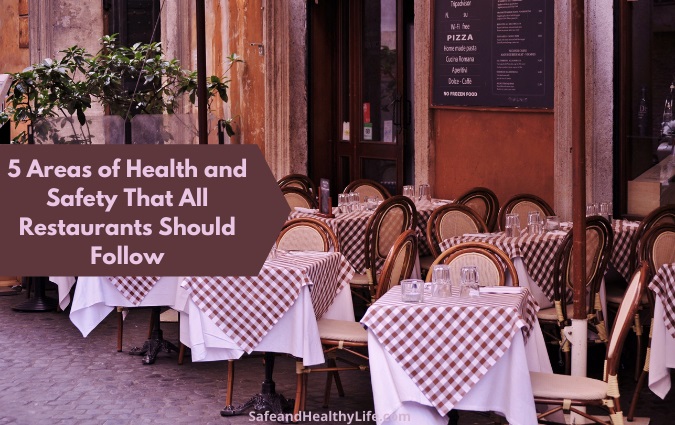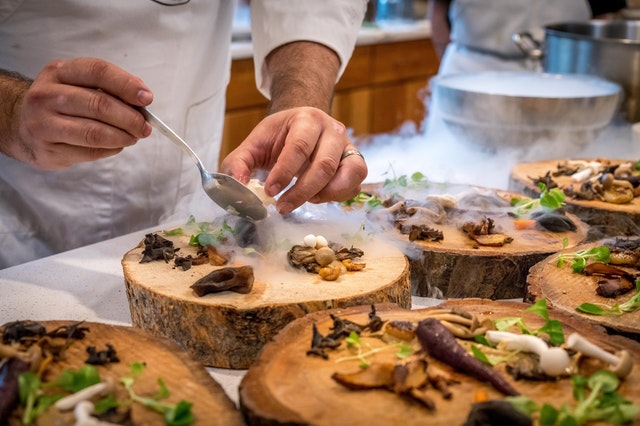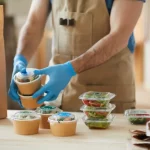
Now more than ever, businesses need to be extremely careful when preparing food. With the increased risk due to the Covid-19 pandemic, ensuring everyone’s safety is vital so that we can all work together to stop the spread.
In this article, we are going to take a look at five health and safety tips that all restaurants should definitely be following.
Let’s get started.
1. Food safety
No matter if you use a distributor or purchase all of the groceries yourself, food safety and handling is vital in any place that serves meals. There are many different rules you should follow to do this, so make sure all of your staff have completed the necessary food handling training.
Raw meat should never be stored next to cooked, and fridge temperatures should remain at a safe degree. This minimizes the risk of bacteria and contamination, which can have severe impacts on one’s health.
Monitoring temperatures during the cooking process is also critical as some food needs to be cooked all the way through. As a guide, any beef, chicken, or turkey that is ground should hit 160°F.
Poultry and microwaved animal products should hit 165°F, while the internal temp of eggs, pork, fish, and beef should be 145°F.
It’s also vital to use cleaned and sanitized equipment and rinse any fresh produce that you will be using. Some items will also need to be replaced regularly, such as sponges, rags, and dish towels.
They can be a haven and breeding ground for harmful germs. Click the link to learn more about the importance of food safety so that you can make sure you are delivering the best food possible.
2. Personal hygiene
Personal hygiene is another extremely important step that all restaurants should follow when preparing and serving food. Sanitizing, washing hands, and keeping ourselves groomed reduces contamination, prevents food poisoning, and stops the spread of other viruses and infections.
To ensure your staff follow this, provide a work locker where they can store their clothing and personal items. During work hours, no staff should wear jewelry, and any injuries must be covered and protected appropriately with bandages. Check out these personal hygiene tips for more advice.

3. Fire safety
The kitchen is one of the most fire-prone areas, so all staff should know what to do in these types of situations. While you might not realize it, there are different types of fires that have to be put out in different ways. Some need to be extinguished with water, while others are better to be smothered or put out with a special dry powder agent.
Without following the right steps, the situation may worsen, so try and learn the different classes!
On top of this, safety gear such as a fire blanket and extinguisher should be easily accessible to all staff, and the building should be equipped with smoke alarms.
An evacuation plan also needs to be displayed in the case of an emergency, including any necessary policies and procedures that should be followed.
4. Protective equipment

Photo by Hemant Latawa from Unsplash
No matter how careful they are, the kitchen staff is always at risk of burns and injuries when working, especially in a face-paced environment. All it takes is a small oil spill to cause some severe damage. This is why investing in a protective uniform and other safety equipment is vital.
Staff should also wear closed footwear that is of high-quality, slip-resistant, and sturdy. Improper shoes are one of the leading causes of accidents in kitchens. Alongside this, hairnets or hats and gloves should also be used to help reduce cross-contamination.
5. Electrical hazards
Just like kitchens are prone to fires, electrical hazards can also be present. There are many different gadgets and appliances that are situated in a commercial space, and water can quickly make it’s way to their cords without anybody realizing it. This is why you must always inspect them frequently for signs of damage.
Every few months, they should also be marked and observed by a professional so that you know everything is in working order.
Kitchen staff should also follow any manufacturer instructions for their equipment. They are there for a reason! Otherwise, they may be putting themselves at risk.
Final thoughts
And that’s it! These were five areas of health and safety that all restaurants should follow. By ensuring that you follow this guide, you can provide the best quality food and service to your guests while growing your business.
The last thing you want is to be shut down by an inspector. Make sure you have the proper policies and procedures in place and follow all the necessary regulations. The future of your restaurant depends on it.
About the Author:
Jessica Downey is a freelancer and blogger outreach, service provider. She enjoys writing informative articles about a range of different topics to help individuals find the information they need.




